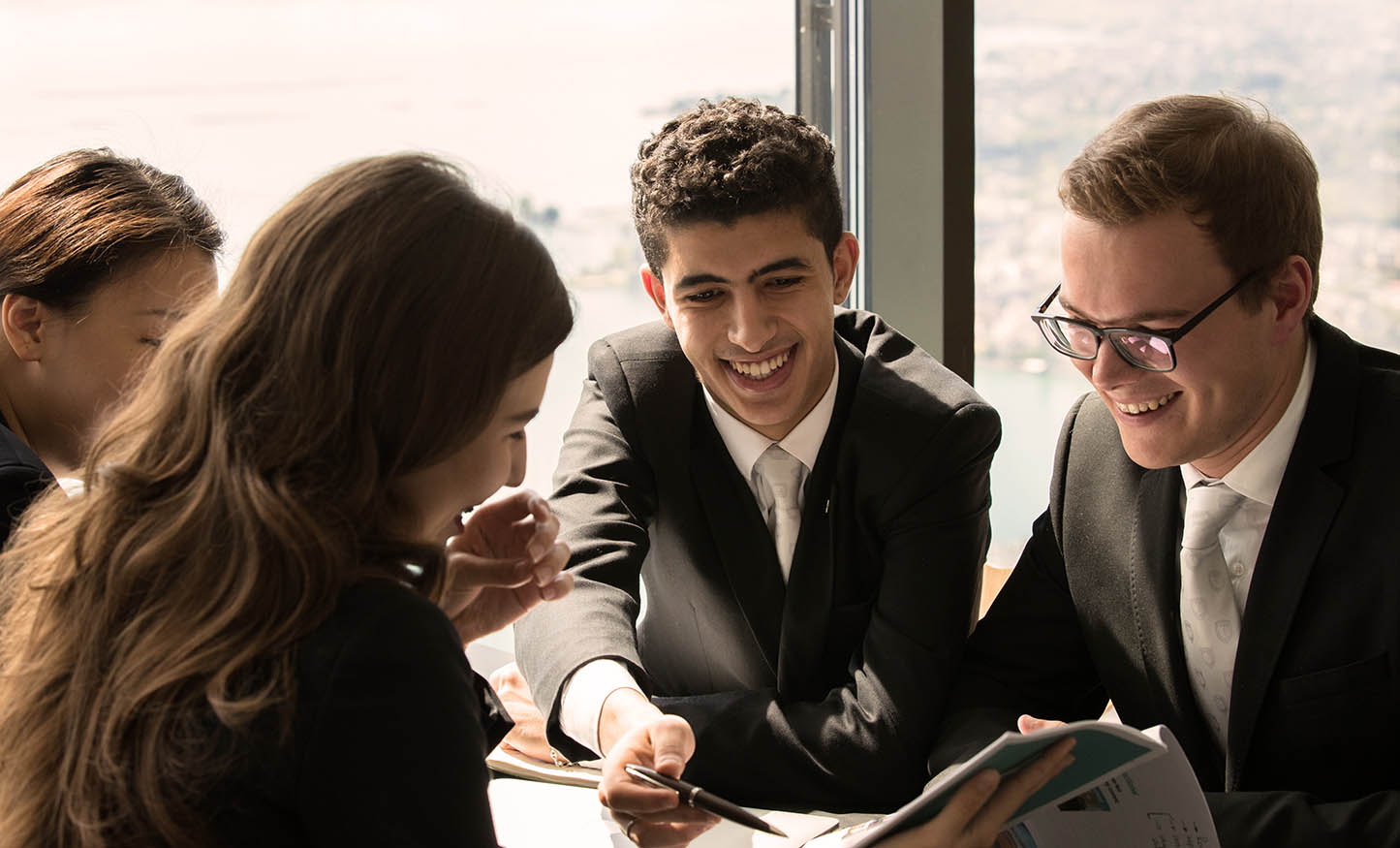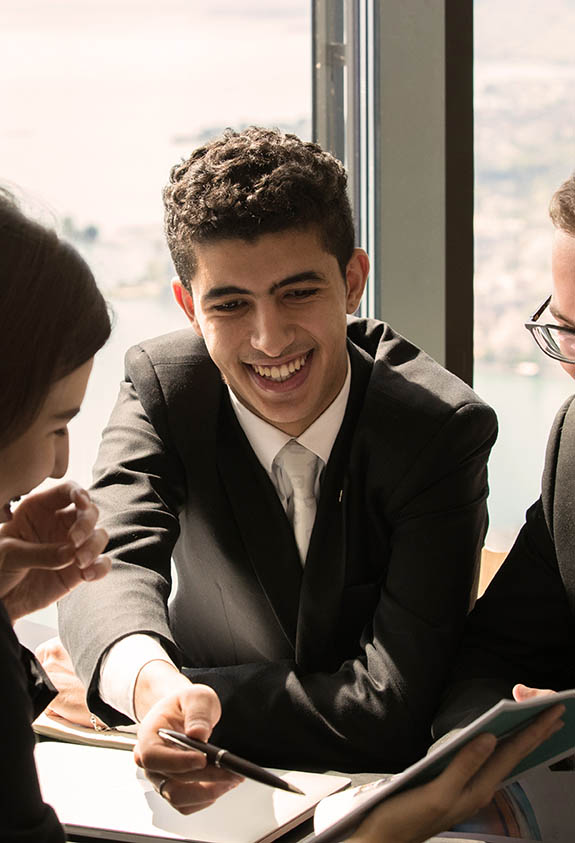This summer, Glion was approached by Villeneuve à Venir, a local non-profit organization that promotes the sustainable development and the promotion of local community, its historic, cultural, and social heritage. With little more than a month to prepare, our students were asked to conduct a feasibility study for the renovation and repurposing of the piece of land and create a presentation for the stakeholders. Working in groups, the students were given a “blue sky” brief with the instructions to think outside the box and come up with an innovative concept.
Hospitality Business Concepts
In their multicultural groups, the students took a creative approach to choosing and expanding on their hospitality and tourism business concepts. From the five different groups, came five different ideas:
- Le Chocolatier, a chocolate-themed hotel with a café and spa
- A’vone Ville, an open space hotel village concept and event venue
- The Fingle & Wingle, a foodie hotel and marketplace for mingling
- Le Grand Ecran Hotel, a cinema-themed hotel
- La Cupola, an eco-hotel dome that produces zero waste
Creativity aside, the students went deep into the details of the services and facilities that would be featured on-site to a level of detail that was truly astounding. In addition to presenting the business concept and details, the groups were assigned to conduct their research based on a standard feasibility study outline which covered the following points.
Market Area Analysis
The students gathered information about the economic and demographic profiles of the region. This meant researching facts and trends concerning the domestic population, economic factors that impact the region and the tourists. Overall, they presented a remarkable amount of data and drew conclusions concerning the impact of certain factors such as the strong Swiss franc, the Consumer Confidence Index (CCI), the seasonality of tourism, and the possible implications of the project for employment in the region.
Apparently, this wasn’t always easy, as one student admitted: “During the research, we couldn’t really find the detailed numbers for Villeneuve, it’s such a specific area and the information was limited. So finding those facts wasn’t easy for a location that is not very big. Also Villeneuve has some protected areas and regulations, all of which are written in French, so for our non-French speaking classmates we had to translate.”
Project Site and Area Analysis
Each group presented significant research on the location of the project site and the accessibility. In the case of accessibility, they concluded that efficiency of the Swiss public transportation systems and the proximity of a highway off-ramp made the site easily accessible for domestic and international tourists. They also listed notable features and attractions which are existing magnets for visitors in the region. They even addressed the more complex issues concerning the site adaptability, taking into account the zoning, building codes and licencing.
Competition Analysis
When it came to analysing the competition, our students set the bar high by comparing their projects with hotels and event concepts from around the world. Since the project site had few high-quality hotels to compete with, they took a broader look at the competitors around the world. By doing so, the students took a step back from the traditional Swiss model of palace hotels and boutique hotels to present some very innovative concepts. They looked at everything from similar hotel themes and infrastructures, to the pricing and quality ratings, to get an idea of whether their hotel concept could beat the competition and draw tourists specifically to the hotel as a new feature.
Demand Analysis
Another tricky question that the students had to answer was that of demand: who would want to stay in their hotel, for how long, and how much would they be willing to pay? To gauge these answers, the students conducted surveys. The details of the survey methodology and response rates were not specified, but it was clearly a good exercise for the students to practice surveying and drawing conclusions based on the responses. In addition to the survey data, they also looked at similar hotels for pricing and occupancy rates to determine demand.
Financial Analysis
In this section of the presentation, the amount of care and precision that went into each project was evident, and the students really did think big with ideas that ranged in budget from CHF 7 million to nearly CHF 100 million.
The financial analysis is important for investors who need to know the bottom line and our students delivered by showing their calculations and presenting a final recommendation, a “go or no go” conclusion for the proposed concept. To their credit, the students of one hotel concept even admitted that their original plan was not feasible, due to the property costs, so they offered three alternatives to cut the cost of development and render the hotel plan viable. These calculations leave little to chance. Using their knowledge of rooms division and revenue management for hotels and restaurants, they provided a solid analysis of how much they would have to charge guests and how long it would take to stabilize the income and make the business profitable for the long term. This is where we really see the progress that students make during their long road from the hotel school classes of the first year to this final year of studies.
Student Reflections and Conclusions
After the excitement and adrenalin of the presentation had passed, we caught up with a few of these students to hear their feedback. And in terms of building experience for their future careers, this type of project is highly appreciated by the students.
“I think we were all very excited about this project because the investors were actually coming to see us, and maybe taking our ideas to develop it. That’s why for us it was really exciting and we put a lot of effort into it. We liked it,” says Jade Matarasso, a student from the group that presented the foodie hotel “Fingle and Wingle”.
Her classmate Tanya Zapata Sutcliffe concurs: “Going in front of the investors lends a reality to the situation because you’re presenting a project to real investors and this is how the real world works, so it’s a great project for us to experience how the real world works and not just a project for school. It’s something that I feel is very beneficial for the future and whatever business we want to do.”
“We had to adhere to a certain structure but how we approached each element was up to us,” says Denis Golovanov, one of the Chocolatier group members. And apparently there were some bumps along the way: “In terms of creativity, in the finance track we are very “by the book” so we have barriers, and for this project we didn’t have barriers at all. We could go crazy, we could do anything,” classmate Jade Matarasso added, “Because we had such very broad guidelines, we had to find a way to tackle the situation and it was difficult for us to think outside of the box and present something very different, very innovative, and yet remain concrete.”
Overall, the students all concurred that this project helped them to prepare for the next step in their lives: graduation and professional life. The stakeholders shared their appreciation for the hard work and creativity that went into the projects and presentations.
Win-Win for Students and Business Partners
Glion Institute of Higher Education incorporates real-world business case studies into the curriculum because they teach our students to approach business projects the right way, taking into account all the various factors, under the guidance of experienced faculty members.
“It’s all about linking theory with practice,” explains Claudio Zucco, the faculty member who worked with program leader Pia Huh to coordinate the project with the industry stakeholders.
“This type of project is about taking a specific case and working through the details to arrive at a profitable solution. It’s an excellent exercise in entrepreneurship and our students arrived at some very realistic conclusions. Participating in this sort of project is good for the students in many ways, but most of all, it gives them experience with the current trends and issues that tourism and hospitality businesses face.”



















